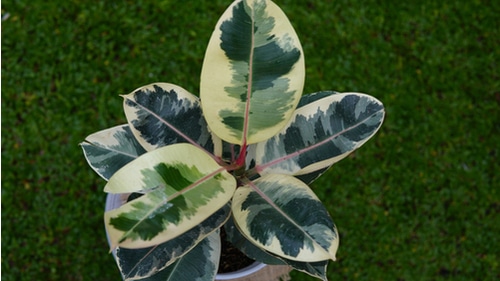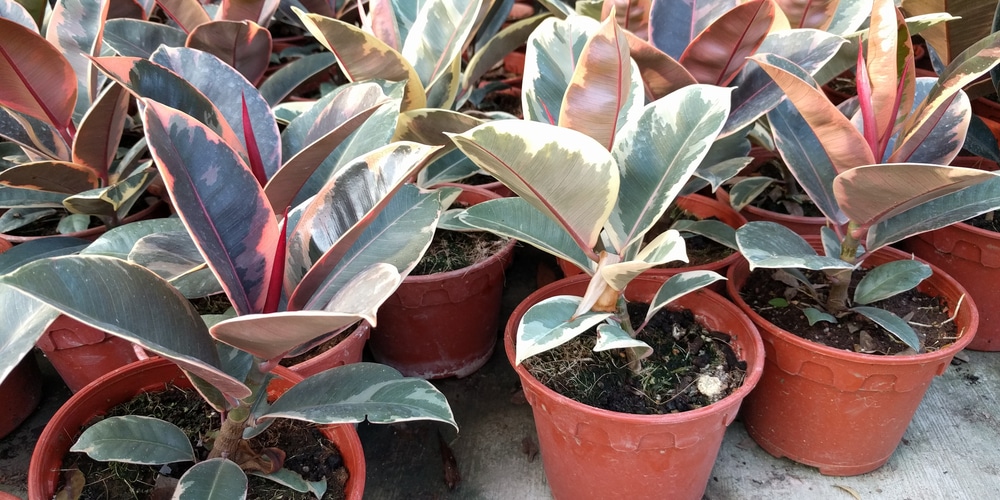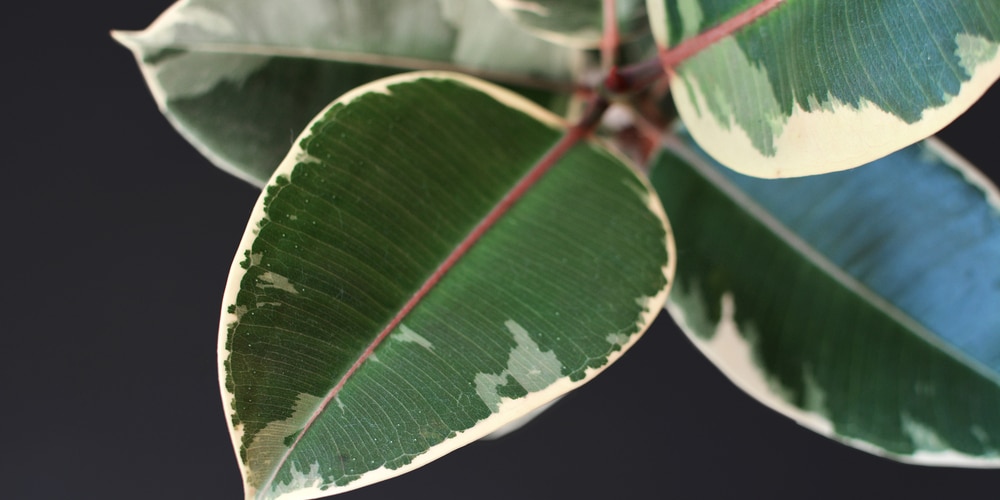If you’re looking for a houseplant that adds an accent or makes a bold statement in your home, you can never go wrong with Ficus Tineke. Native to southeast Asia, Ficus Elastica Tineke is a beautiful variegated variety of rubber plants. It is a versatile, tough, and easy to maintain plant known for its excellent air purification properties.
What Does a Ficus Tineke Look Like?
Ficus Elastica Tineke is well-loved in conservatories, offices, entrance halls and is increasingly gaining popularity for living spaces again. But how can you tell the plant you’re purchasing is genuinely Ficus Tineke? Here’s how you can identify the Ficus Elastica Tineke:
- Coloration: The Ficus Elastica Tineke leaves are large, thick, shiny, and leathery. They feature glossy tricolor variegated patterns of gray-green, green, and creamy white with a tinge of burgundy or maroon. The coloration is usually most intense in new leaves and will slowly fade as they mature.
- Size and growth: When left outdoor, Ficus Elastica Tineke can grow up to 50 feet tall but grows between 2 and 10 feet tall as a houseplant. The leaves can span up to 5 inches wide and 12 inches long.
- Flowering: When grown in their native habitat, the plant flowers are white blooms. However, indoor-grown Ficus Elastica Tineke rarely flowers.
- Fragrance: The plant has a minimal scent that attracts fig wasps only.
First Steps After Purchase
Besides being one of the most beautiful houseplants, Ficus Tineke is easy to grow and care for. Below are a few necessary steps to ensure that the plant acclimatizes to its new environment after purchasing it.
Repot your plant
In most cases, Ficus Elastica Tineke is sold in a plastic pot. Therefore, it’s best that you repot your plant in a terracotta or well-drained container that’s about 1-2 inches larger than your plant.
Apply insecticides
Even if you just bought it, you can’t be sure that your plant is pest-free. So spray the plant with neem oil, insecticidal soap, or other horticultural oils.
Quarantine your new plant
Yes, your Ficus Tineke needs to be put in a quarantine pot and away from other houseplants for at least 2-3 days.
Maintain favorable temperatures
Ficus Elastica Tineke is highly sensitive to changes, especially in temperatures and light. It does well in temperatures of 15-29 °C, and when it drops, it may start to lose foliage.
Ensure fairly moist soil
Keep the soil moist, especially for the first couple of weeks. If the soil is dry then soggy, you’ll cause waterlogging, where the roots become mushy, soft, and then die. Leaves respond by turning yellow, wilting, and later falling off.
Give bright, indirect light
It’s important to ensure that your plant receives enough light, especially if it was in an outdoor nursery. You can place it on a window facing east to get the much-needed direct sunlight. Failure to do this, your Ficus Elastica Tineke can lose beautiful cream variegation and start to drop leaves.
How to Care for The Ficus Elastica Tineke
You should offer Ficus Elastica Tineke consistent care for best results. Typically, your job doesn’t end after buying and placing it on the window- beauty takes work. Here’s how to care for the plant properly:
Lighting
Ficus Elastica Tineke does best in bright, indirect light. You can also leave the plant out in the sun only for a few hours a day.
Consistent temperatures
You should maintain the average room temperature of 55° degrees Fahrenheit. Inconsistent or sudden temperature drops, dry conditions, and cold drafts can negatively affect the plant.
Watering
Water the plant when the soil becomes slightly dry to touch. Don’t overwater the plant as it can result in root rot and fungus gnats.
Humidity
The plant thrives in normal humidity levels. You can consider adding a humidifier in summers when the air indoors is dry.
Fertilizing
Feed the plant with liquid fertilizer during its growing period (the warmer months). Avoid feeding it over the cooler winter periods.
Pruning
As a houseplant, the Ficus Elastica Tineke doesn’t require much pruning. But, to achieve a bushier and fuller appearance, you should prune to remove unwanted branches and aerial roots.
Please Note: Wear gloves when pruning since the plant’s exterior milky sap can irritate the skin.
Grooming
Large Ficus Elastica Tineke leaves can collect dust over time. So, from time to time, you can use a damp cloth to clean the thick, waxy leaves to keep them glossy.
Pest and diseases
Ficus Elastica Tineke might be prone to pests such as aphids, leaf and root mealybugs, spider mites, and plant scale. It can sometimes be prone to fungal diseases such as anthracnose. So, be on the lookout and mitigate accordingly.
The plant may also suffer from leaves browning due to:
- Low humidity
- Too much direct sunlight
- Overfertilizing leads to salt buildup
Related: Ficus Altissima
Conclusion
Ficus Elastica Tineke is one of the loveliest houseplants you can have in your living space. You can add it as an accent plant, décor centerpiece, or pizzazz to a group of other plants in your house. Besides, it’s easy to care for and maintain.
Related: Ficus Triangularus


